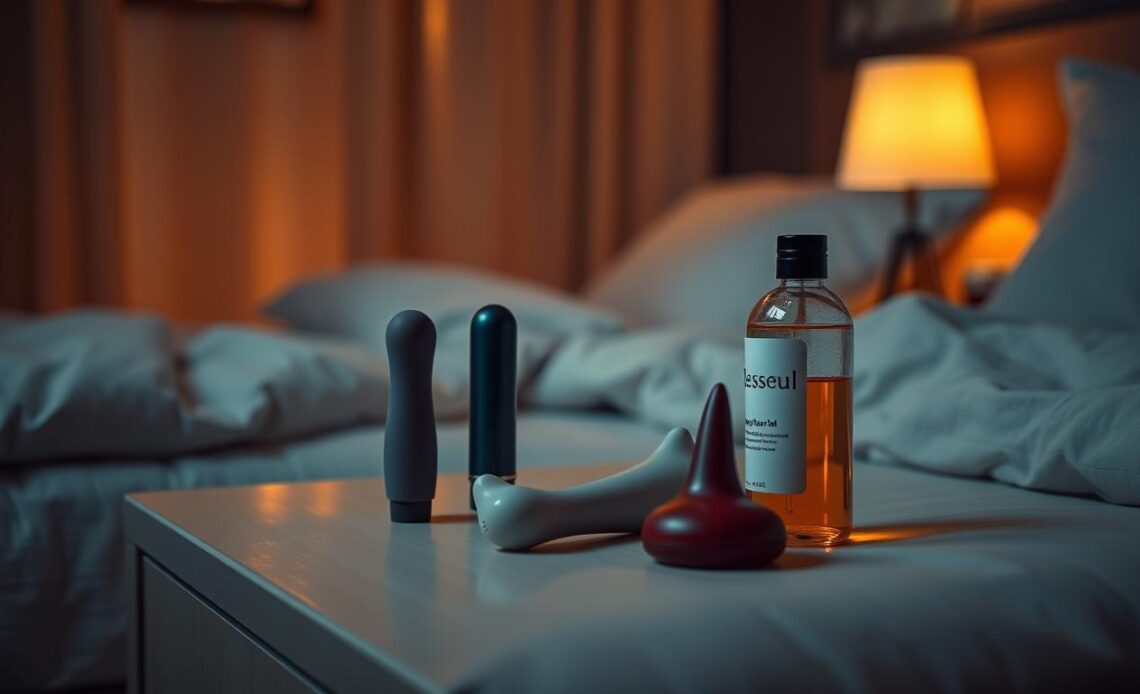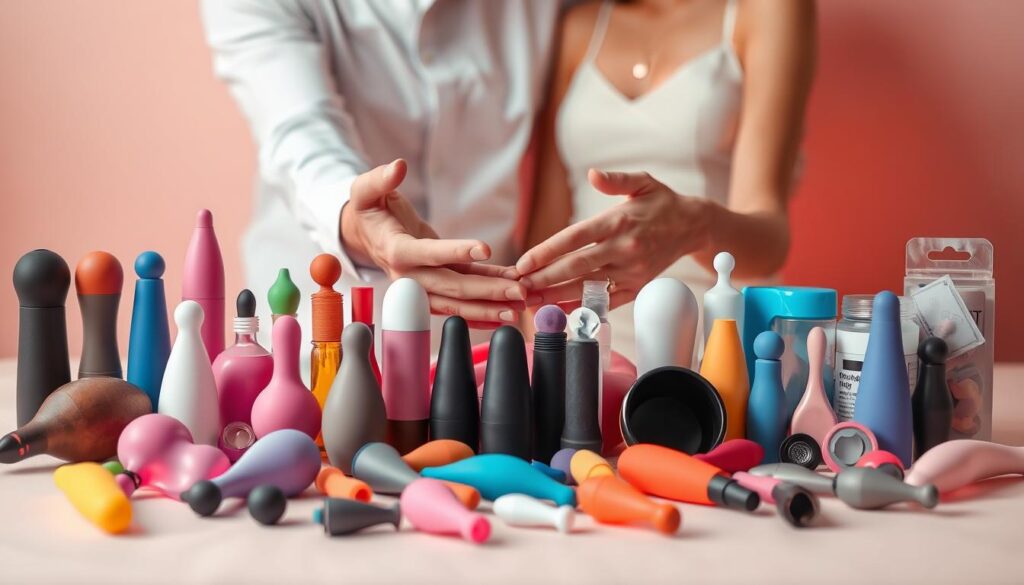
Let’s face it – talking about bedroom accessories can feel awkward at first. Many of us grew up in environments where discussing these tools was considered taboo. But what if we told you that exploring pleasure products could actually strengthen relationships and boost confidence?
A recent intimacy survey revealed 68% of people felt more self-assured after just three solo sessions. This guide helps you navigate initial hesitation while discovering how these tools can enrich your connection with yourself or a partner. We’ll break down common myths and provide actionable strategies to overcome hesitation.
Think of this as your friendly roadmap. Whether you’re curious about solo exploration or couple’s play, we combine psychological readiness tips with practical suggestions. Our approach focuses on creating safe spaces for discovery – because everyone deserves fulfilling experiences free from judgment.
Key Takeaways
- Open conversations reduce stigma around intimacy tools
- 83% of couples report improved relationship satisfaction
- Gradual exploration builds comfort and confidence
- 72% of partners experience better communication
- Pleasure products complement – don’t replace – human connection
Understanding Sexual Anxiety and Its Impact on Our Lives
Many of us carry invisible weights into our private moments. That flutter in your chest before closeness? It’s often rooted in cultural whispers we’ve absorbed since childhood. Our ability to connect deeply gets tangled in unspoken rules about what’s “normal” or “expected.”
When Nervousness Meets Closeness
Experts note that 1 in 3 people experience physical hesitation during private moments. This isn’t about capability – it’s our mind interpreting vulnerability as risk. Dr. Elena Torres explains: “The brain’s threat response activates even in safe environments when we anticipate judgment.”
These reactions often stem from mixed messages. We’re told intimacy should feel natural, yet rarely taught how to navigate its complexities. This gap leaves many feeling unprepared, creating cycles of self-doubt that affect relationship quality.
Breaking Through Silent Barriers
Cultural narratives play a surprising role. Many grew up hearing that seeking pleasure tools means failing your partner – a myth that ignores how 74% of couples using them report stronger emotional bonds. Limited education compounds this, leaving people without proper information to make informed choices.
By reframing our understanding, we create space for growth. Recognizing these patterns helps us address root causes rather than symptoms. It’s not about fixing individuals, but building environments where exploration feels safe and encouraged.
sex toys sexual anxiety
Exploring new pathways in relationships often begins with curiosity. When we broaden our toolkit for connection, we create opportunities for growth that benefit both solo and partnered experiences. Let’s uncover how modern approaches can reshape our comfort zones.
Why Pleasure Tools Can Help Ease Tension
Introducing accessories into private moments isn’t about replacing human touch – it’s about enhancing what already exists. These devices act as collaborators, offering fresh methods to discover preferences and reduce pressure. “When we remove expectations of perfection,” notes intimacy coach Mara Klein, “we make room for authentic enjoyment.”

Breaking Down Stigma Through Dialogue
Cultural attitudes are shifting rapidly – 64% of millennials now view these products as normal self-care items. What once felt taboo becomes empowering when approached with honesty. Start small: share a lighthearted article or discuss preferences during relaxed moments.
Creating judgment-free zones lets us address hesitations naturally. Remember, openness strengthens bonds – 79% of partners feel closer after exploring new experiences together. It’s not about instant transformation, but gradual steps toward mutual understanding.
Preparing for a More Comfortable Sex Life
Building confidence in intimate moments starts long before the bedroom door closes. We often focus on physical aspects, but true comfort grows from thoughtful preparation of both mind and environment. By addressing psychological readiness and practical needs together, we create foundations for positive experiences.
Psychological Readiness and Mindset
Start with self-reflection. What expectations feel realistic? Therapist Jamie Lee suggests: “Write down three curiosity-driven goals instead of performance-based ones – this shifts focus from pressure to discovery.” Discuss these thoughts with partners if exploring together, creating shared understanding without judgment.
Practice grounding techniques like deep breathing to ease into new experiences. Remind yourself there’s no “perfect” outcome – exploration itself becomes the win.
Practical Preparations and Safety Considerations
Choose body-safe materials like medical-grade silicone. Check product certifications – reputable brands share testing details openly. Clean items thoroughly before first use, following manufacturer guidelines.
Designate a private area free from interruptions. Soft lighting and familiar music can ease nerves. Keep lubricants nearby for comfort, opting for water-based options compatible with most materials.
Remember: pacing matters. Begin with simpler designs before exploring advanced features. These steps transform preparation from chore to empowering ritual.
Choosing the Right Sex Toy for You and Your Partner
What makes a pleasure product truly right for you? The answer lies in balancing practical features with emotional readiness. Let’s explore how thoughtful selection can turn this process into a confidence-building exercise for all involved.

Material, Size, and Quality Considerations
Start by prioritizing body-safe materials. Medical-grade silicone and ABS plastic rank highest for safety and durability. Check for certifications like FDA approval or CE markings – reputable brands display these prominently.
Size matters more than you think. A compact design often works better for beginners, while adjustable settings help customize experiences. Read product descriptions thoroughly – look for cleaning instructions and warranty details to gauge long-term value.
Assessing Our Needs Together
Schedule a relaxed conversation to share preferences. Try completing this sentence together: “We want something that helps us…”. This simple exercise clarifies goals without pressure. Many couples discover shared interests they hadn’t considered before.
Browse reviews focusing on real-user experiences. Look for patterns – if multiple people mention easy controls or quiet operation, that’s valuable quality information. Remember, the best choices complement your unique dynamic rather than following trends.
When both partners feel heard during selection, the product becomes a bridge rather than a barrier. As intimacy coach Rachel Mills notes: “Collaborative choosing builds trust – it’s practice for navigating other relationship decisions.”
Effective Communication with Our Partners
Conversations about personal preferences can feel like walking a tightrope – balance matters more than speed. Choosing the right moment transforms delicate discussions into opportunities for growth. Research shows 61% of couples prefer initiating these talks during shared downtime, like after a relaxing meal or weekend morning coffee.
Timing and Approach for Sensitive Conversations
Start by observing natural rhythms. Does your partner open up more during evening walks or Saturday brunches? Match the setting to their comfort zone. Relationship coach Derek Mills suggests: “Frame discoveries as shared adventures rather than critiques – ‘I found this interesting article about enhancing closeness’ works better than ‘We need to talk.'”
| Approach | Timing | Language | Outcome |
|---|---|---|---|
| Shared curiosity | Leisurely weekends | “What if we tried…” | 83% positive response |
| Abrupt demands | Stressful workdays | “You should…” | 67% resistance |
| Educational angle | Pre-planned dates | “I read about…” | 79% engagement |
Simple phrases create safe spaces. Instead of technical terms, try: “I’d love to explore new ways to connect” or “Could we look at options together?”. This reduces pressure while inviting collaboration.
When discussing specific aids like vibrators, present them as tools for mutual enjoyment. Browse educational resources side-by-side – many partners appreciate visual examples over abstract descriptions. Remember: joint decision-making strengthens trust and satisfaction.
Practical Tips for Using Sex Toys in Intimate Settings
Transforming intimate moments starts with thoughtful preparation and playful curiosity. By blending preparation with experimentation, we create space for discovery that feels natural rather than forced. Let’s explore how to weave these tools into routines while maintaining connection and comfort.
Creating a Relaxing Atmosphere with Foreplay
Set the stage with sensory elements that ease tension. Soft lighting and familiar music work wonders for shifting focus from nerves to enjoyment. Begin with activities you both already love – a massage or shared laughter lowers defenses.
Introduce devices gradually during these moments. Relationship coach Tina Patel advises: “Place the product nearby without immediate pressure to use it – familiarity reduces apprehension.” This approach lets curiosity build organically.
Step-by-Step Introduction and Usage Techniques
Start with non-intimidating designs like compact massagers or textured rings. Apply them to non-sensitive areas first – shoulders or thighs – to acclimate to sensations. Water-based lubricants enhance comfort during initial experiments.
Follow this simple progression:
- Discuss boundaries and interests beforehand
- Incorporate the tool into foreplay gently
- Check in verbally or through body language
- Adjust pressure/speed based on feedback
Many couples find success using detailed guides as conversation starters. Remember – small steps lead to lasting confidence. Celebrate discoveries rather than rushing toward specific outcomes.
Enhancing Our Sex Lives: Overcoming Barriers and Building Confidence
Transformative journeys often begin with a single “what if” moment. Take Mark and Lena, who reignited their 12-year marriage by exploring sensory tools during weekend getaways. Their story mirrors countless others – ordinary people discovering extraordinary connection through guided experimentation.
Real-Life Success Stories and Expert Advice
Relationship specialist Dr. Nina Patel shares: “Couples who start with non-intimidating products see 40% faster progress in comfort levels.” Her clients often begin with simple accessories like massage oils or textured gloves before progressing to more specialized items.
Consider these patterns from successful pairs:
- Weekly “discovery chats” over morning coffee
- Trying one new technique monthly
- Celebrating small wins like laughter during experiments
Many find our step-by-step vibrator guide helps bridge knowledge gaps. Free video tutorials and curated product lists remove guesswork, letting couples focus on shared growth rather than technical details.
Breaking barriers isn’t about dramatic changes. It’s building trust through consistent, playful exploration – and knowing expert support exists when needed. Your breakthrough moment might be closer than you think.
Conclusion
Our journey through intimacy often reveals unexpected paths to connection. By embracing open dialogue and gradual exploration, we transform apprehension into opportunities for growth. The strategies we’ve discussed – from mindset shifts to practical preparations – help create safer spaces for discovery.
Every partnership charts its own course. What works for some might differ for others, and that’s perfectly normal. Revisiting conversations about preferences keeps our approach fresh and aligned with evolving needs. Remember how Mark and Lena reignited their bond through small, playful experiments?
Experts consistently highlight three essentials: curiosity over pressure, quality communication, and respecting individual comfort levels. These principles apply whether we’re navigating new experiences alone or with others. The right tools become allies when chosen thoughtfully and used mindfully.
For those seeking guidance, countless resources exist – from educational articles to certified intimacy coaches. Your next step might be simpler than you think. Why not revisit one conversation this week with renewed openness?

